A “60/40 Portfolio” consists of 60% equities and 40% bonds. It gained traction in the 1970s and 1980s as pension funds, endowments and individual investors began applying Modern Portfolio Theory (MPT), developed by economist Harry Markowitz in the early 1950s, to combine asset classes.
From Balanced to Resilient
The 60/40 Portfolio May No Longer Cut It
A “60/40 Portfolio” consists of 60% equities and 40% bonds. It gained traction in the 1970s and 1980s as pension funds, endowments and individual investors began applying Modern Portfolio Theory (MPT), developed by economist Harry Markowitz in the early 1950s, to combine asset classes.
Notably, the 1980s provided an ideal environment for mixing stocks and bonds. Fed Chair Paul Volcker raised interest rates to nearly 20% by 1982 to curb stagflation, and the disinflation that followed fueled strong stock returns. Investors with 60/40 allocations generally earned solid returns and lower volatility. Equities delivered strong results historically, but swings were sharp. With bonds added to the mix, returns remained appealing, while volatility was reduced thanks to bonds’ steadier return profile, which is charted in Figure 1 on the next page.
Constructing a 60/40 portfolio was also simple, a valuable trait when trading costs were high and execution was difficult. Investors could own one stock fund and one bond fund. Rebalancing to maintain the 60/40 split was common but not mandatory. The simplicity also provided peace of mind. Many investors still gravitate toward the 60/40 model, anchoring on past norms that were shaped by a unique interest rate regime. But forward-looking assumptions may need to adapt as today’s market differs from the one decades ago.
Figure 1 shows investors fully invested in the S&P 500 index since 1979 outperform those with a blended portfolio by an average of 1.4% per year. On the surface, that might suggest a pure-equity portfolio is superior. But that conclusion doesn’t hold for every investor. In Figure 2, we chart portfolio risk, defined as standard deviation (how much a portfolio’s value fluctuates around its average) calculated over rolling five-year periods. While investors with long time horizons often accept short-term volatility as the price of higher long-term return potential, not everyone has the ability or willingness to wait. Many folks rely on their portfolios to fund expenses, cover unexpected needs or meet other near-term obligations.
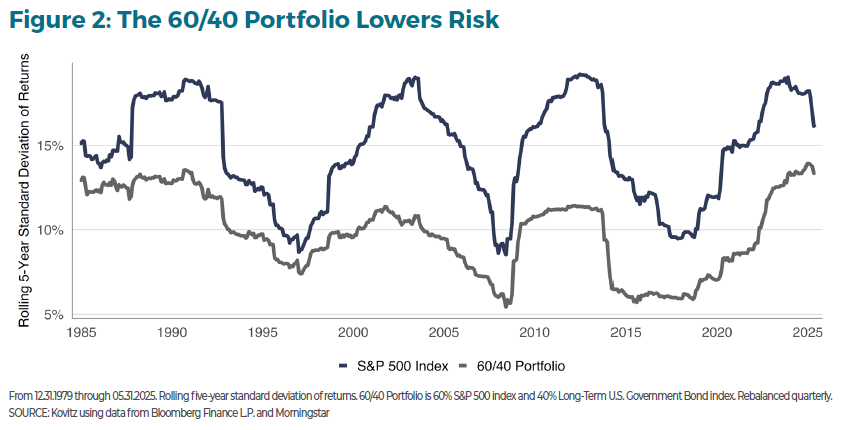
By diversifying into a more stable asset class (bonds), 60/40 investors captured 89% of the return since 1979 and experienced around 10% annual volatility, which is a third lower than the all-equity portfolio. The reduction matters to many for peace of mind and for practical matters, like living expenses and other cash movements.
60/40 Portfolio Under Pressure
“A modern portfolio needs more than a balanced diet, it needs a diversified pantry.”
— Charles Schwab AM
SMOOTHING OUT THE RIDE
Fixed income helps dampen the volatility that often accompanies stock investing. While equities have historically delivered higher long-term returns, they are prone to sharp draw-downs in the face of economic stress, geopolitical shocks or shifting interest rate expectations. Bonds, by comparison, tend to exhibit lower price fluctuations and often hold up better when stocks falter. In a balanced portfolio, such as the classic 60/40 mix, fixed income serves as a stabilizing force, reducing overall portfolio swings and helping investors navigate turbulent markets with greater confidence and composure.
Figure 3 shows this cushioning effect. Though the S&P 500 has risen over time, it has never avoided experiencing an intra-year decline. The blue dots mark the index’s largest annual peak-to-trough drop, while the grey dots represent the corresponding decline in a 60/40 portfolio. The difference is often substantial. By smoothing the ride, fixed income improves an investor’s ability to stay the course and reduces the risk of making ill-timed withdrawals during market stress.
Bear Markets
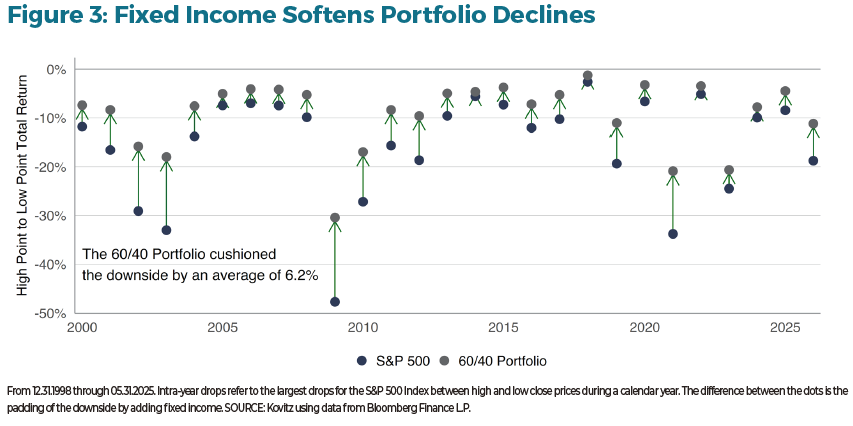
A 60/40 Portfolio has historically offered better protection than an all-stock allocation during Bear Markets, softening the blow when equity prices decline sharply. When stocks tumble, high-quality bonds have provided ballast, either holding their value or even appreciating as investors seek relative safety.
Looking at the most recent six Bear Markets (drops of 20%+) in Figure 4, the benefits of this approach are evident. During the first leg down of the dot-com bust in 2000 and 2001, the S&P 500 index lost 37% on a price return basis and 36% including dividends, while the 60/40 Portfolio tumbled ‘just’ 17% overall.
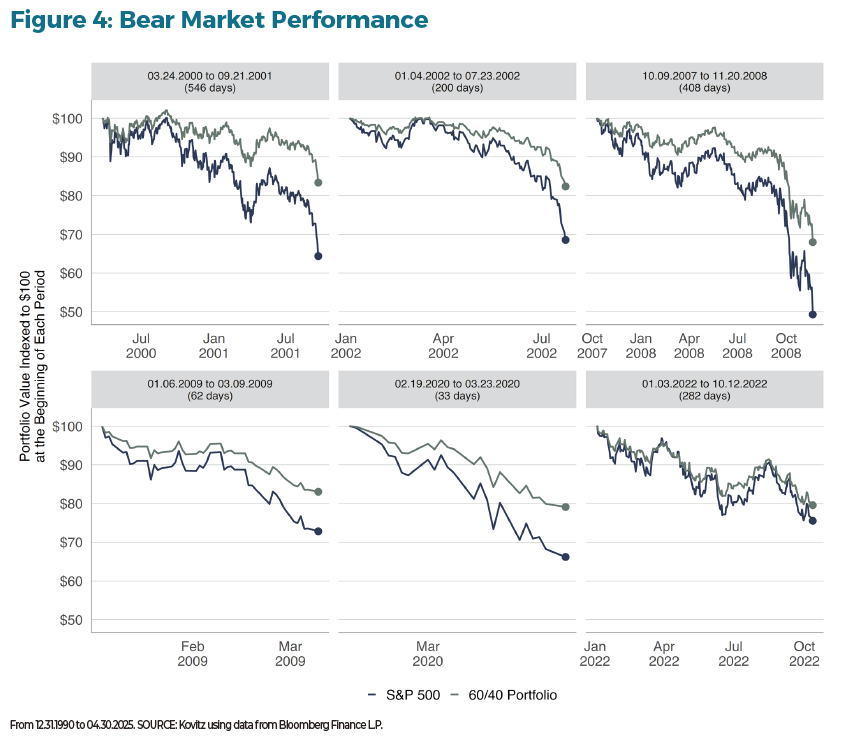
In 2007 and 2008, the Great Financial Crisis caused equities to fall more than 51% including dividends, while the 60/40 Portfolio experienced a 32% decline. Sometimes, declines are faster. In early 2009, stocks lost a total of 27% of their value over just 62 days, compared with 17% for the 60/40 portfolio. And the COVID-19-related drop was the shortest Bear Market on record, just 33 calendar days in duration with a -34% return for the S&P and -21% for the 60/40 Portfolio.
It’s evident that bonds have provided a cushion for plunging equities, and over longer periods and across most Bear Markets, the strategy has proven effective in limiting paper losses and helping investors stay invested through a variety of market environments.
A GRAND BREAKDOWN IN 2022
2022 marked the first true test of the 60/40 Portfolio in decades. In an unusually hostile environment defined by inflation shocks and rapidly rising interest rates, both sides of the traditional balanced portfolio came under pressure simultaneously. Stocks struggled as the S&P 500 index fell about 18%, weighed down by surging inflation, aggressive Federal Reserve rate hikes, geopolitical instability (most notably the war in Ukraine) and growing recession fears. Growth-oriented stocks, which had led the prior Bull Market, were hit particularly hard.
Concurrently, the bond market offered little protection. The Fed raised rates at the fastest pace in decades to rein in inflation, sending bond prices sharply lower across the yield curve. The Bloomberg U.S. Aggregate Bond index declined more than 13%, its worst calendar-year performance on record. Losses were even steeper on the “long end” of the curve. TLT, an iShares ETF tracking 20+ year U.S. Treasury bonds, fell 31% in 2022 and 41% from the end of 2021 through October 19, 2023. Unfortunately, what was widely viewed as the “safe” side of the portfolio turned out to be anything but.
Throughout much of 2022, stocks and bonds moved in tandem—downward. The traditional diversification benefit of combining the two asset classes broke down because both were reacting negatively to the same macro force: rising interest rates. With inflation unanchored and short-term rates moving from near-zero to above 4%, few safe havens remained.
Figure 5 charts the performance of the S&P 500 alongside our baseline 60/40 Portfolio (navy line). Because all bonds are not the same, we constructed alternative 60/40 portfolios subbing in different types of fixed income exposure, including short-term bonds, long-term government bonds and corporate bonds, to explore how those choices impacted results.
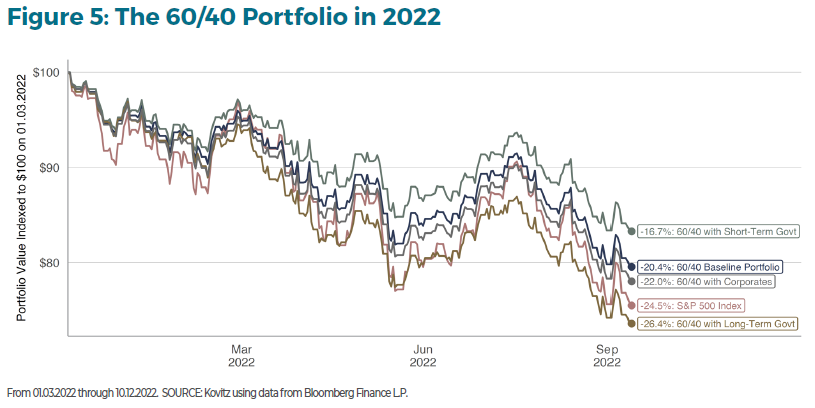
In today’s 4%+ yield environment, it’s easy to forget the backdrop leading up to 2022. For more than a decade, interest rates hovered near zero. In some cases, the time required to double one’s bank deposits at prevailing yields stretched beyond 6,000 years! Investors needing income (but not inclined to overweight dividend-paying stocks) often owned longer-dated bonds for their higher yields, not realizing they carry more interest rate risk. That approach generally worked…until it didn’t in 2022. When inflation surged and rates reset, the duration risk that had quietly accumulated became a source of sharp pain.
Regime Shift
” We may be moving into a new environment — one that is less benign for asset prices, more uncertain for investors, and more challenging for policymakers.”
— Jerome Powell, August 2022
The assumptions about stock and bond returns that underpinned 60/40 allocations broke in 2022. We think the framework is not obsolete, but it must evolve to remain effective. Long-term merits of holding a mix of quality stocks and other assets that support your personal financial goals remain, but we warn that the path ahead demands a more nuanced approach.
HIGHER FOR LONGER
After more than a decade of near-zero interest rates, the investment landscape has shifted. Central banks, led by the Federal Reserve, have signaled a willingness to maintain elevated policy rates to contain inflation and re-anchor expectations. While rates have come off the highs (the current Fed Funds Rate is 4.5% in Figure 6, down from a peak of 5.5% in Q3 last year), central banks have been willing to maintain a “higher-for-longer” posture that looks to avoid a quick return to easy-money days of the past. This shift has broad implications for asset prices, borrowing costs and valuation multiples.

Fixed income investors, long starved for yield, now find attractive entry points across the curve. For equities, this means a greater emphasis on companies with strong cash flow, reasonable valuations and durable competitive advantages.
VOLATILE INFLATION DYNAMICS
The era of predictable, low inflation appears to be ending. A confluence of forces (including deglobalization, fiscal expansion, reshoring of supply chains, tariffs and mounting resource constraints) has added complexity to inflation tracking. While recent data points have shown moderation (Figure 7), volatility has risen above the historically low levels we enjoyed over the preceding decades. Happily, for now, we remain a ways off the inflationary volatility of the 1980’s.
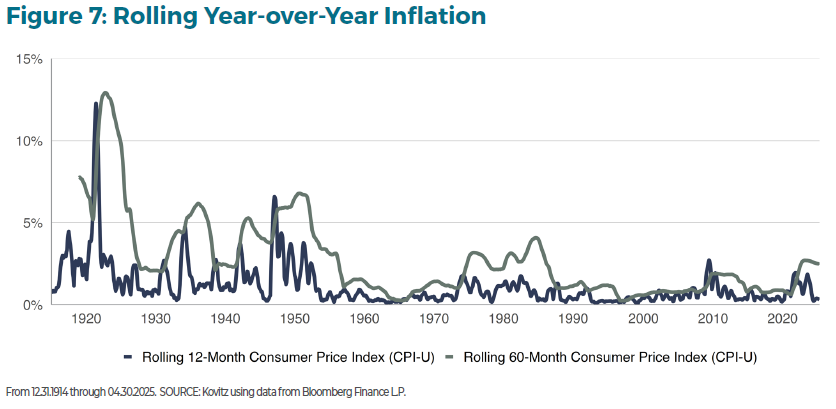
STRUCTURAL DRIVERS
Several slow-burning forces continue to reshape the economic backdrop. High public and private sector debt levels limit policymakers’ flexibility and raise questions about future taxation and spending. Aging populations in developed markets strain social programs and reduce workforce participation, acting as a natural drag on growth. Meanwhile, geopolitical realignment, spurred by shifting alliances, regional conflicts and a broader move toward multi-polarity, has introduced new risks to global capital flows and supply chain stability. These forces don’t manifest overnight, but they shape the opportunity set and underscore the need for thoughtful global diversification and scenario planning.
NEW INVESTMENT OPTIONS
Investors today benefit from a broader and more sophisticated opportunity set than ever before. From access to private credit and infrastructure to thematic vehicles focused on artificial intelligence, clean energy and frontier markets, the menu has expanded well beyond traditional stocks and bonds. Interval funds, ETFs, direct deals and specialized vehicles now allow investors to fine-tune their exposures in ways that once required institutional-level access. This evolution empowers more precise portfolio construction, but it also demands greater diligence, as complexity often accompanies innovation.
LOW COST INVESTING
Technological progress has meaningfully reduced transaction costs across asset classes. Bid-ask spreads have tightened, commissions have largely disappeared and market access has been democratized. While this empowers investors to be more agile, it also increases the temptation to trade too frequently or to chase momentum. In our view, lower friction should be used not as an excuse to tinker, but as a means to implement long-term strategies more efficiently.
Constructing an asset allocation is as much an exercise in imagination as it is in discipline. While the past can offer helpful lessons, we believe portfolios should be constructed with eyes on the horizon, not the rear-view mirror. A thoughtfully designed opportunity set reflects a genuine commitment to long-term wealth creation. So what belongs in that mix?
Rethinking 60/40 Portfolio Asset Classes
“A broader toolkit leads to better portfolio construction. Investors now have access to exposures that were once only available to institutions.”
— Morgan Stanley WM
EQUITIES: THE ENGINE OF GROWTH
At the heart of successful asset allocations lies a diversified collection of equities (preferably of the Value variety). We continue to favor active management, aiming to multiply capital efficiently while keeping valuation discipline, risk awareness and dividend income front and center. We seek to identify fundamentally sound businesses trading below our estimate of their intrinsic value, buying them with conviction, and harvesting gains once that value is realized.
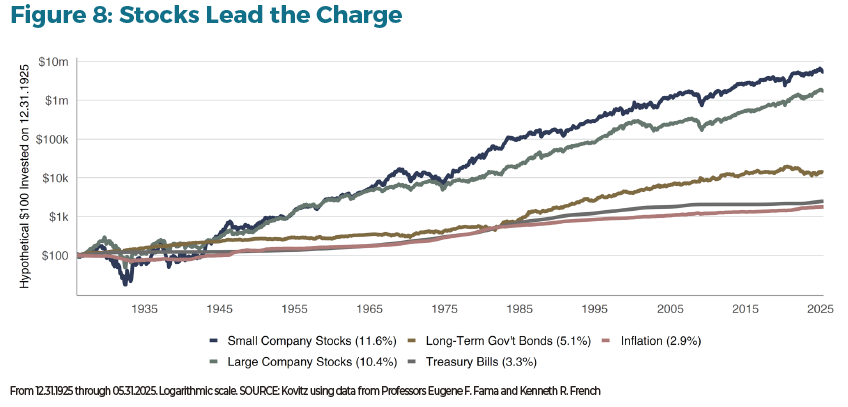
Beyond core stock holdings, factor-based strategies, including those emphasizing dividends, smaller-cap companies or international value, can complement a traditional equity sleeve. These tilts seek to exploit persistent return premiums observed over long periods, while also enhancing diversification and, in some cases, delivering steady income. In our view, they serve to enrich the equity allocation without diluting the return potential that makes stocks such a powerful long-term growth vehicle.
BONDS: INCOME / STABILITY
Though bonds rarely generate headlines, their role in a balanced allocation remains vital. Fixed income can offer cash flow, stability and downside protection, particularly when equities are under pressure. Bond allocations are often constructed from a blend of U.S. Treasuries, investment-grade corporates, municipals, mortgage-backed securities and inflation-linked instruments like TIPS. Each plays a role in addressing interest rate exposure, credit risk and inflation dynamics.
Duration and credit quality deserve special attention. Shorter-term bonds can help contain interest rate risk, while longer maturities may offer higher returns in falling-rate environments. Investors can also explore satellite allocations. High-yield bonds, preferreds, floating-rate loans or emerging market debt can enhance yield, albeit with added risk.
We prefer to use bond ladders, illustrated in Figure 9, which offer a measure of yield stability over time. Even as interest rates decline in later years (we model a hypothetical yield drop in the figure), staggered maturities help maintain consistent reinvestment opportunities and income.
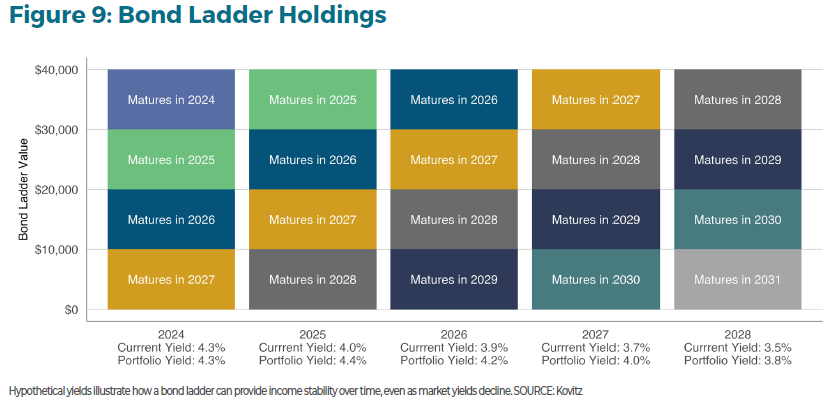
When used thoughtfully, fixed income can improve a portfolio’s risk-adjusted profile and act as ballast through equity market turbulence.
REAL ASSETS: TANGIBLE VALUE
We’ve always appreciated the growth power of individual equity portfolios, but that philosophy extends naturally to real assets. Direct ownership of real estate, especially properties that generate income, can provide equity-like total returns, without the daily price swings of publicly traded securities. Real estate can be highly tax-efficient and offer a reliable stream of cash flow, making it appealing to income-focused investors.
When properly executed, both focused and diversified real estate allocations can contribute meaningfully to portfolio resilience, while serving as a hedge against inflation. For investors with the time (the ability to have money locked up)and temperament, private equity offers another growth lever. These long-term investments, often in undervalued private companies, can produce excess returns relative to public markets, though they come with greater complexity and illiquidity. Niche offerings like equity conversion and options strategies may also
serve as useful roles in asset allocations, depending on the investor.
ALTS: SMOOTHING THE RIDE
The path to financial success is rarely smooth and never without risk. That’s where diversifiers and alternatives like hedged equity, defined outcome and buffered strategies come in. These approaches use options-based techniques to limit downside risk while allowing for a measure of upside participation. It’s important to understand that these strategies do not eliminate risk or guarantee returns, but help investors stay the course during periods of market stress by reducing the impact of sharp drops.
Defined outcome and buffered strategies offer preset protection levels and outcome ranges over set periods, which can be useful for investors seeking more predictable results within their equity exposure. In today’s environment of elevated volatility and geopolitical uncertainty, they provide a valuable layer of stability. For those who want to remain invested in equities while limiting downside shocks, these tools serve as a thoughtful complement to traditional asset classes.
ALTS: PRIVATE CREDIT
As traditional bank lending contracts, private credit has emerged as a growing opportunity for yield-seeking investors. Loans to middle-market businesses, real estate developers or asset-backed borrowers offer high income potential (often floating-rate) and attractive spreads over public debt markets. While less liquid and requiring careful underwriting, private credit provides diversification and return potential in portfolios willing to trade liquidity for income.
ALTS: PRIVATE EQUITY
Private equity has long appealed to investors with extended time horizons and the willingness to accept illiquidity in pursuit of higher returns. By investing in privately held businesses, these strategies aim to unlock value through operational improvements, strategic reworking and long-term capital stewardship. PE investments typically require a multi-year lockup and have added complexity, but those able to withstand illiquidity and capital calls find that private equity can serve as a powerful growth engine, complementing traditional equity holdings and potentially enhancing overall portfolio returns.
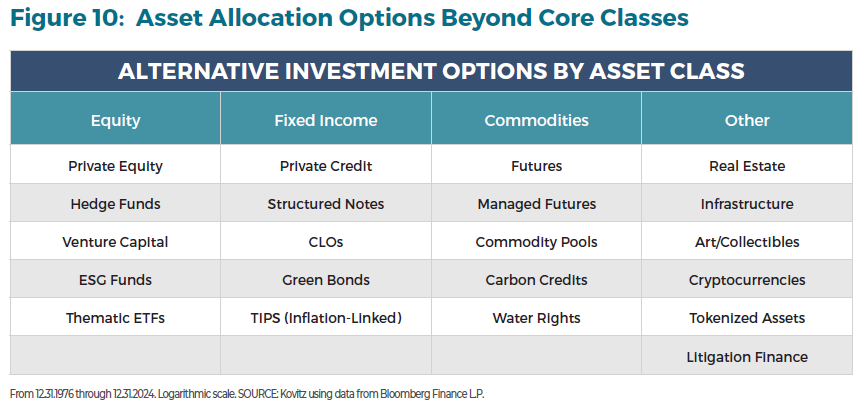
LOOKING AHEAD
As always, we advocate for patient, long-term ownership of high-quality assets held with conviction and calibrated to the investor’s unique needs, goals and time horizon. Diversification is not about chasing every trend, but about staying the course when the winds inevitably shift to ensure long-term return targets are met.
Consider These Things
“The essence of investment management is the management of risks, not the management of returns.”
— Benjamin Graham
Today’s investors face a markedly different landscape than in years past. Elevated volatility (Figure 11), trade spats, shifting tides and diverging asset class behavior demand a more flexible, rigorous approach to asset allocation. While we remain steadfast in our long-term philosophy, we recognize the need to reassess portfolio construction to navigate these evolving dynamics.
RISK MANAGEMENT
Risk management isn’t about eliminating uncertainty. It’s about preparing for it. Thoughtful portfolio design acknowledges that markets will ebb and flow, often without warning. We believe in embracing risk where it’s rewarded, mitigating it where it’s not and diversifying exposure across multiple dimensions. Traditional exposures like bonds and cash often pair nicely with alternatives and real estate in helping manage draw-downs and ensure overall portfolio resilience.
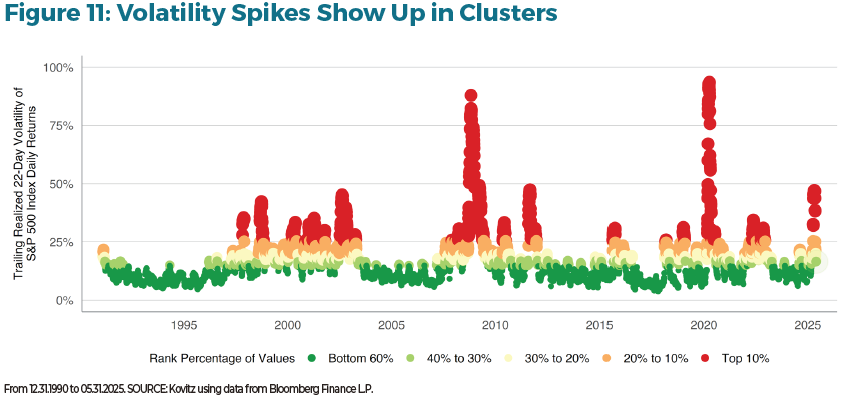
FACTOR INVESTING
Factor-based investing (e.g. Value, Momentum, Quality or Low Volatility) offers an intuitive, evidence-backed way to enhance risk-adjusted returns. These exposures, when combined thoughtfully, help spread portfolio risk across different economic drivers. We think of this not simply as “smart beta,” but as smart risk budgeting: positioning capital in ways that aim to minimize sharp losses while capturing long-term upside. Understanding how factors behave in different market regimes improves decision-making when volatility strikes.
EVOLVING EXPOSURES
Allocations should be more than static pie charts. They should reflect conviction and opportunism. In today’s environment, it makes sense to incorporate strategic tilts toward trend-following and global macro strategies that may thrive in less correlated markets. Likewise, targeted allocations to emerging opportunities—such as the energy transition, artificial intelligence (A.I.) or demographic growth stories—can provide long-term tailwinds when sized appropriately. These “slices” can add both dynamism and diversification to core holdings.
ACCESS TO ALTS
Private investments are increasingly accessible to individual investors through vehicles like interval funds, feeder structures and customized SMAs. These channels open the door to private equity, private credit and real asset strategies, providing exposure to differentiated return streams and the potential for an illiquidity premium. While the benefits are compelling, thoughtful implementation remains essential. Investors must weigh access terms, capital call schedules and liquidity constraints alongside their own financial profile.
REBALANCING
Volatility often creates discomfort, but it also creates opportunity. Rebalancing (buying what has fallen or trimming what has risen) is a time-tested discipline that reinforces long-term behavior. Strategic rebalancing can help maintain portfolio integrity without forced selling. Rebalancing also supports risk control and capital efficiency across cycles.
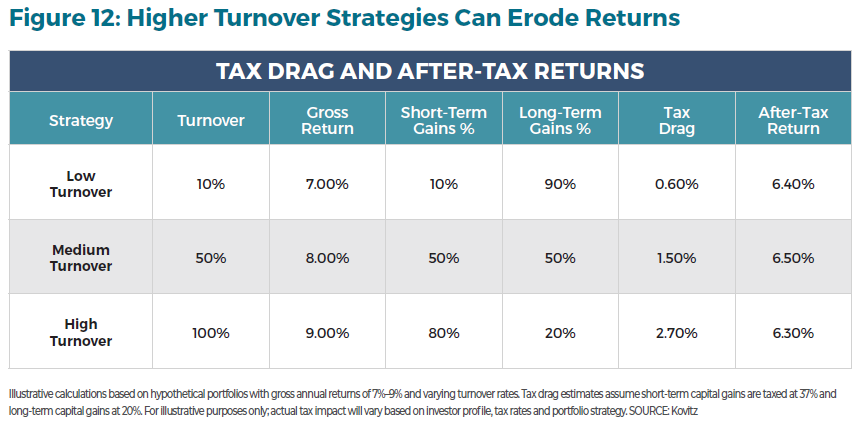
PAY ATTENTION TO TAXES
In taxable portfolios, after-tax returns are what truly matter. That’s why we advocate for tax-sensitive investing, including the management of distributions, strategic harvest of losses and careful selection of tax-friendly vehicles (aligned with broader goals). In Figure 12, we show how tax drag erodes growth over time, with the high-turnover strategy requiring a 2% better return to arrive at the same after-tax return as the low-turnover strategy. Long-term investors should weigh more than just returns, ensuring they get to keep those gains in support of their financial objectives.
BEHAVIORAL FINANCE
Even the soundest asset allocation can be undone by emotions. Investors are often their own worst enemies, prone to selling in fear during downturns and chasing returns during rallies (Figure 13). While markets will always ebb and flow, patience and discipline remain the great differentiators between those who grow their wealth and those who erode it. We believe that a thoughtfully constructed portfolio should not only weather market turbulence, but also help investors stay invested through it. That means setting realistic expectations, avoiding emotional overreactions and focusing on time in the market, not market timing. Risk cannot be eliminated, but behavioral pitfalls can be managed with patience, perspective and a long-term view.
IMPLEMENTATION CONSIDERATIONS
Access: Investors today have more tools than ever, including interval funds, direct deals, feeder funds and separately managed account (SMA)platforms that all offer pathways to broaden exposure to alts and non-traditional strategies.
Costs & Complexity: While fees should always be scrutinized, some higher-cost structures can be justified if they provide differentiated access, alpha potential or tax efficiency. Still, simplicity remains a virtue where it can be maintained.
Risk Management: Transparency and oversight are crucial. Investors must understand liquidity terms, stress-test cash flow assumptions and evaluate worst-case scenarios before stepping too far outside traditional markets.
Tailoring: Effective asset allocation goes beyond templates, incorporating tax-aware strategies, estate planning considerations and goals-based investing to align portfolios with each investor’s unique financial picture.
Liquidity ladder model: A tiered approach to liquidity helps match short-term cash needs with stable assets while positioning longer-term capital for growth, reducing the need for reactive changes during periods of market stress.
DEFINING SUCCESS
Success isn’t just about returns. It’s about reaching your personal goals with clarity and consistency. It’s important to understand what drives performance, how to manage risk and stay disciplined through market swings. In our view, true success means meeting long-term objectives while avoiding costly mistakes.
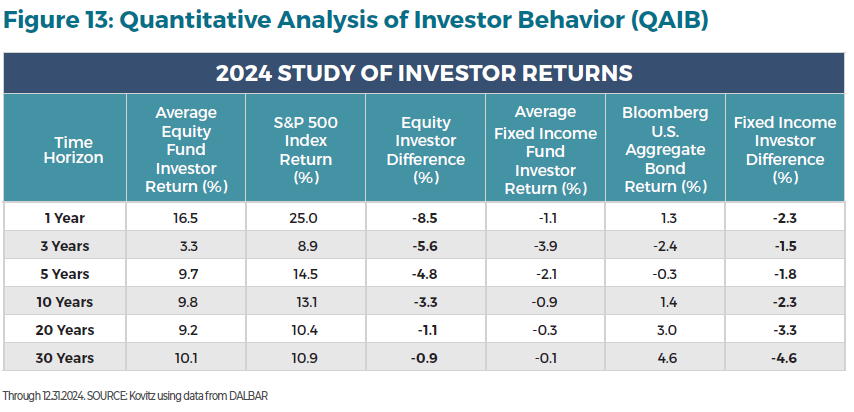
Holistic Wealth Management
“Every balance sheet tells a story. Great wealth management makes sure it ends well.”
– Industry Aphorism
Asset allocation is not just about what you own; it is about how all the parts work together. That requires looking beyond asset classes to consider the interaction among managers, strategies and the underlying securities themselves. Aggregating exposures across funds helps identify unintended concentrations or gaps. We believe that a holistic lens leads to stronger portfolios, better aligned with your goals, more resilient under stress and constructed with full awareness of how each component supports the whole.
Many investors find comfort in traditional portfolio models, such as the 60/40 blend, not only because they are familiar but also because they appear straightforward. Introducing new asset classes, alternative strategies or less liquid exposures can feel unsettling, even when backed by sound reasoning. Rebalancing away from legacy frameworks often requires recalibrating emotional anchors and building trust in a modernized approach. That process begins by recognizing each client’s starting point and working together to adjust the strategy in a way that supports their unique financial circumstances. The goal is not to abandon what has worked but to evolve the strategy in a way that achieves long-term goals.
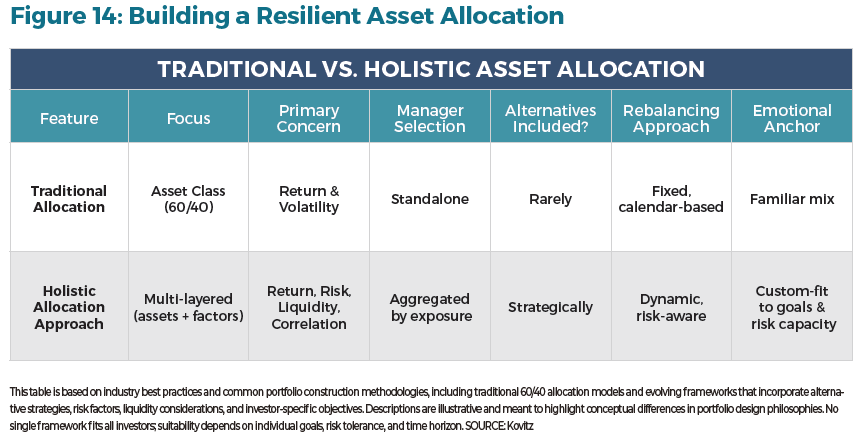
PURPOSEFUL COMMUNICATION
We work with clients to strengthen their portfolios by focusing not only on potential return benefits, but also on how changes align with their broader financial objectives. We have found that framing these discussions around purpose, risk management and resilience creates stronger, more enduring financial foundations. Our intent is never to add complexity for its own sake, but to design strategies that meet and exceed your personal goals with clarity and confidence.
BRINGING IT ALL TOGETHER
We use Addepar, a sophisticated reporting platform, to help clients move beyond fragmented views of their accounts toward a clear and complete picture of their overall financial position. By consolidating equities, private investments, cash reserves and other assets into cohesive reports, clients gain better insight and control. This transparency is especially important when introducing new exposures (such as private equity, real estate or hedged strategies) because it presents the portfolio not as a collection of parts, but as a unified, intentional plan.
RESETTING EXPECTATIONS
Investor expectations were shaped by decades of falling interest rates and strong equity returns. It is easy to forget that we experienced two Bear Markets since 2020 and narrowly avoided another two (including one in 2025) on the technicality that Bear Markets are counted on end-of-day prices. We believe today’s environment calls for an allocation reset. With more modest return assumptions across traditional asset classes, it is essential to recalibrate expectations without losing confidence. That means focusing on what can be controlled: thoughtful allocation, disciplined rebalancing, tax-aware implementation and a long-term mindset.
Remaining invested through volatility, understanding the role of illiquid assets and avoiding emotional decision-making all require guidance, consistency and trust. We have seen that regular, proactive communication (anchored by tools like The Prudent Speculator newsletter) helps bridge the gap between investment strategy and investor behavior. It is what keeps clients on the path to success.
INTELLIGENT DIVERSIFICATION
In today’s evolving investment landscape, the case for intelligent diversification has never been stronger. Rather than clinging to outdated notions of a static, balanced portfolio, we believe investors should seek a strategy that is more durable and resilient. The coming decade is unlikely to mirror the last. It will reward those who approach allocation actively and thoughtfully, not passively or out of habit. Markets have changed. Risks have shifted. New opportunities have emerged. So too should your portfolio. Thoughtful, forward-looking diversification is not only prudent, it is essential for the unknown that lies ahead.
A NOTE ABOUT US
We offer a wide range of investment opportunities woven into a comprehensive financial planning framework tailored to each client’s needs. Our objective, long-term approach to financial planning covers the full spectrum of wealth management, including investment strategy, financial planning, estate review and tax-related considerations. We work collaboratively with your attorneys, tax advisors and team of professionals to ensure alignment across all aspects of your financial life. If needed, we also provide access to a trusted network of contacts.
Our wealth advisors and financial planners bring deep experience and a commitment to delivering objective, thoughtful advice. We believe the strongest allocations (and the strongest client outcomes) come from aligning sound strategy with personalized guidance.
If you are ready to move beyond outdated models and embrace a more resilient, forward-looking approach, we would welcome the opportunity to partner with you to build a plan that reflects not only where the world is headed, but where you want to go. We invite you to start the conversation.



